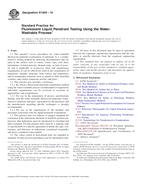Wir benötigen Ihre Einwilligung zur Verwendung der einzelnen Daten, damit Sie unter anderem Informationen zu Ihren Interessen einsehen können. Klicken Sie auf "OK", um Ihre Zustimmung zu erteilen.
ASTM E1220-10
Standard Practice for Visible Penetrant Testing Using Solvent-Removable Process
Automatische name übersetzung:
Standard Praxis für Visible Eindringprüfung Mit Lösemittel Removable Prozess
NORM herausgegeben am 15.2.2010
Informationen über die Norm:
Bezeichnung normen: ASTM E1220-10
Anmerkung: UNGÜLTIG
Ausgabedatum normen: 15.2.2010
SKU: NS-40911
Zahl der Seiten: 6
Gewicht ca.: 18 g (0.04 Pfund)
Land: Amerikanische technische Norm
Kategorie: Technische Normen ASTM
Kategorie - ähnliche Normen:
Die Annotation des Normtextes ASTM E1220-10 :
Keywords:
nondestructive testing, penetrant testing, solvent-removable method, visible liquid, Leak testing, Liquid penetration, Nonferrous metals/alloys, Nonporous metallic/nonmetallic materials, Penetrant inspection, Seams, Solvent removable penetrants, Surface analysis--metals/alloys, Aerosol spray applications, Black light inspection, Ceramic materials/applications, Cold shuts, Contaminant removal, Cracking, Dwell test, Electrostatic spray application, Ferrous metals/alloys, Glass, Impurities
Ergänzende Informationen
| Significance and Use | ||||||||||||||||||||||||||||||
|
Liquid penetrant examination methods indicate the presence, location, and, to a limited extent, the nature and magnitude of the detected discontinuities. This practice is intended primarily for portability and for localized areas of examination, utilizing minimal equipment. Surface roughness may be a limiting factor. If so, an alternate process, such as water-wash visible or post-emulsified penetrant should be considered when grinding or machining is not practical. |
||||||||||||||||||||||||||||||
| 1. Scope | ||||||||||||||||||||||||||||||
|
1.1 This practice covers procedures for visible penetrant examination utilizing the solvent-removable process. It is a nondestructive testing method for detecting discontinuities that are open to the surface such as cracks, seams, laps, cold shuts, laminations, isolated porosity, through leaks, or lack of fusion and is applicable to in-process, final, and maintenance examination. It can be effectively used in the examination of nonporous, metallic materials, both ferrous and nonferrous, and of nonmetallic materials such as glazed or fully densified ceramics and certain nonporous plastics and glass. 1.2 This practice also provides a reference: 1.2.1 By which a visible penetrant examination method using the solvent-removable process recommended or required by individual organizations can be reviewed to ascertain its applicability and completeness. 1.2.2 For use in the preparation of process specifications dealing with the visible, solvent-removable liquid penetrant examination of materials and parts. Agreement by the purchaser and the manufacturer regarding specific techniques is strongly recommended. 1.2.3 For use in the organization of the facilities and personnel concerned with the liquid penetrant examination. 1.3 This practice does not indicate or suggest standards for evaluation of the indications obtained. It should be noted, however, that after indications have been produced, they must be interpreted or classified and then evaluated. For this purpose there must be a separate code, specification, or a specific agreement to define the type, size, location, and direction of indications considered acceptable, and those considered unacceptable. 1.4 All areas of this practice may be open to agreement between the cognizant engineering organization and the supplier, or specific direction from the cognizant engineering organization. 1.5 The values stated in inch-pound units are regarded as standard. SI units given in parentheses are for information only. 1.6 This standard does not purport to address all of the safety concerns, if any, associated with its use. It is the responsibility of the user of this standard to establish appropriate safety and health practices and determine the applicability of regulatory limitations prior to use. |
||||||||||||||||||||||||||||||
| 2. Referenced Documents | ||||||||||||||||||||||||||||||
|
Ähnliche Normen:
Historisch
15.6.2010
Historisch
15.6.2012
Historisch
15.2.2010
Historisch
15.2.2010
Historisch
15.2.2010
Historisch
1.1.2005
Empfehlungen:
Aktualisierung der technischen Normen
Wollen Sie sich sicher sein, dass Sie nur die gültigen technischen Normen verwenden?
Wir bieten Ihnen eine Lösung, die Ihnen eine Monatsübersicht über die Aktualität der von Ihnen angewandten Normen sicher stellt.
Brauchen Sie mehr Informationen? Sehen Sie sich diese Seite an.



 ASTM E114-10
ASTM E114-10 ASTM E1165-12
ASTM E1165-12 ASTM E1208-10
ASTM E1208-10 ASTM E1209-10
ASTM E1209-10 ASTM E1210-10
ASTM E1210-10 ASTM E1219-10
ASTM E1219-10
 Cookies
Cookies
